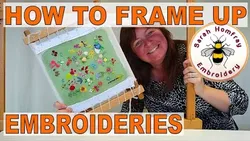
Framing tutorials for hand embroidery 
This course will teach you how to frame your hand embroidery or cross stitch projects. You will learn how to use bar frames, how to attach your embroidery to frames, and the different types of backing fabric for hand embroidery. You will also learn why, what, how and why not to use certain fabrics. By the end of the course, you will have the knowledge to frame your projects with confidence. ▼
ADVERTISEMENT
Course Feature
![]() Cost:
Cost:
Free
![]() Provider:
Provider:
Youtube
![]() Certificate:
Certificate:
Paid Certification
![]() Language:
Language:
English
![]() Start Date:
Start Date:
On-Demand
Course Overview
❗The content presented here is sourced directly from Youtube platform. For comprehensive course details, including enrollment information, simply click on the 'Go to class' link on our website.
Updated in [May 25th, 2023]
This course provides an overview of the techniques and materials used to frame hand embroidery, cross stitch, and needlepoint. Participants will learn how to use bar frames, attach their embroidery to frames, and select the best backing fabric for their project. The course will also cover the “why, what, how, and why not” of framing hand embroidery. By the end of the course, participants will have the knowledge and skills to confidently frame their own hand embroidery projects.
[Applications]
After this course, participants can apply the knowledge they have gained to frame their own hand embroidery projects. They can use the techniques learned to attach their embroidery, cross stitch or needlepoint to frames, as well as learn about the different types of backing fabric and why it is important. Additionally, participants can use the information to make informed decisions about the best way to frame their hand embroidery projects.
[Career Paths]
1. Embroidery Designer: Embroidery designers create unique designs for clothing, accessories, and home decor items. They use a variety of techniques, such as hand embroidery, machine embroidery, and computer-aided design (CAD) to create their designs. As technology advances, embroidery designers are increasingly using digital tools to create their designs.
2. Embroidery Technician: Embroidery technicians are responsible for setting up and operating embroidery machines. They must be familiar with the different types of machines and their settings, as well as the different types of fabrics and threads used in embroidery. They must also be able to troubleshoot any problems that may arise during the embroidery process.
3. Embroidery Framer: Embroidery framers are responsible for framing hand embroidery and cross stitch pieces. They must be familiar with the different types of frames and how to properly attach the embroidery to the frame. They must also be knowledgeable about the different types of backing fabrics and how to properly attach them to the frame.
4. Embroidery Educator: Embroidery educators teach classes on hand embroidery and cross stitch. They must be knowledgeable about the different techniques and materials used in embroidery, as well as the different types of frames and backing fabrics. They must also be able to provide guidance and instruction to students on how to properly frame their embroidery pieces.
[Education Paths]
1. Bachelor of Fine Arts (BFA): This degree program focuses on the development of artistic skills and techniques in a variety of mediums, including hand embroidery. Students learn the fundamentals of design, color theory, and composition, as well as the history of art and the principles of visual communication. This degree is becoming increasingly popular as more people are looking to pursue a career in the creative arts.
2. Master of Arts in Textile Design: This degree program focuses on the design and production of textiles, including hand embroidery. Students learn the fundamentals of design, color theory, and composition, as well as the history of textiles and the principles of textile production. This degree is becoming increasingly popular as more people are looking to pursue a career in the textile industry.
3. Master of Fine Arts in Textile Arts: This degree program focuses on the development of artistic skills and techniques in a variety of mediums, including hand embroidery. Students learn the fundamentals of design, color theory, and composition, as well as the history of art and the principles of visual communication. This degree is becoming increasingly popular as more people are looking to pursue a career in the creative arts.
4. Certificate in Hand Embroidery: This certificate program focuses on the fundamentals of hand embroidery, including the history of the craft, the techniques used, and the materials needed. Students learn the basics of design, color theory, and composition, as well as the principles of hand embroidery. This certificate is becoming increasingly popular as more people are looking to pursue a career in the craft industry.
Course Provider

Provider Youtube's Stats at AZClass
Discussion and Reviews
0.0 (Based on 0 reviews)
Explore Similar Online Courses

Build a Simple Dynamic Site with Nodejs Course

The Elements of English Grammar

Python for Informatics: Exploring Information

Social Network Analysis

Introduction to Systematic Review and Meta-Analysis

The Analytics Edge

DCO042 - Python For Informatics

Causal Diagrams: Draw Your Assumptions Before Your Conclusions

Whole genome sequencing of bacterial genomes - tools and applications

How to do stitching&how to make an embroidery design

Introduction to Freehand Machine Embroidery


Start your review of Framing tutorials for hand embroidery